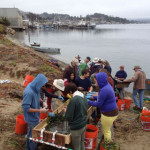Today’s feature on restoration of California’s Morro Bay eelgrass comes to us courtesy of N.O.A.A.
from The Fishing Wire
Morro Bay is a small fishing port situated halfway between San Francisco and Los Angeles on California’s Central Coast. The town is often referred to as the “Gibraltar of the Pacific” because of a volcanic peak that rises nearly 600 feet above the harbor. It is an iconic coastal village closely connected to the sea and the environment that sustains it.
So it was no surprise when local community members, as well as state and federal agencies, responded to a request from the Morro Bay National Estuary Program to help restore the bay’s rapidly declining eelgrass beds.
“Eelgrass is a cornerstone of Morro Bay’s ecosystem,” said Bryant Chesney of NOAA Fisheries. “But over the last several years we have seen eelgrass beds in Morro Bay shrink from about 350 acres to less than 20.”
The exact cause of the decline is unknown, but since the 1850s, eelgrass beds along California’s entire coastline may have declined by as much as 90 percent. Human stressors, such as dredging, nutrient pollution, and sedimentation, are possible causes. However, warming temperatures may also be diminishing the plants’ overall ability to survive.
In Morro Bay eel grass is essential to halibut, juvenile rockfish, leopard sharks, pipefish, and numerous other fish and crustaceans. It also provides habitat for sea birds. Black Brant, for instance, use Morro Bay as one of a few migratory feeding grounds between Alaska and Baja California.
Eelgrass also supports the marine environment by converting sunlight into oxygen. Some studies indicate eelgrass beds may also be capable of absorbing carbon dioxide, an atmospheric gas linked to climate change that can negatively impact the health of our oceans and marine life.
With all of this at stake, it’s no wonder volunteers of all ages and organizations gathered along the shore of Morro Bay to harvest, prepare, and transplant eelgrass back into the upper reaches of the waterway where it has significantly declined.
The restoration process for eelgrass is labor intensive, and this effort was no exception. First divers harvested no more than ten percent from a healthy eelgrass bed and brought it to shore.
Volunteers then washed the leaves and roots, bound several plants together into a single “unit,” and attached a biodegradable “popsicle stick” to act as an anchor. The volunteers prepared nearly 10,000 units to transplant. The plants were then assembled into bundles. From here, a team transported the bundles by boat to the upper portions of the bay where they were transplanted. The shallow water allowed divers to stand up in most places, but they needed scuba equipment to follow a previously positioned underwater line. The divers pushed the roots, or rhizomes, into the sediment every meter along the line. The plants are held fast with the previously installed “popsicle anchor.”
“We are hopeful our efforts will be successful and with this kind of community support, I’m sure it will be,” said Chesney. “The Morro Bay National Estuary Program is a great partnership with federal, state, and local constituencies that care about Morro Bay and its watershed.”
Learn more about eelgrass: http://www.habitat.noaa.gov/abouthabitat/eelgrass.html
